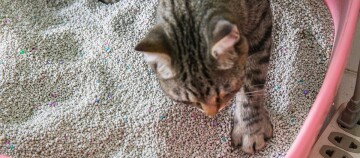Inflammation and Parasites: How to Help When Your Cat's Ear Is Sore
17.10.2022 - Reading time: 4 minutes

Our domestic cat also has the proverbial "ears like a lynx". With their pointed, upright ears, they perceive frequency ranges up to 65,000 hertz, which is about three times the spectrum of human hearing. But that's not all: cats can turn their ears independently of each other and thus localise sounds precisely with sophisticated acoustic angular direction finding, even in absolute darkness. The cat's ears are also used for communication. Through the position of the ears, the cat signals very clearly to you and its fellow cats what mood it is in at any time.
What ear diseases can occur in the cat?
A cat’s ears are therefore a very versatile and sensitive organ, but also a very exposed one that is a target for outside influences and pathogens.
Roughly speaking, the following possible ear diseases can be distinguished:
- Mechanical influences due to injuries or foreign bodies: The auricles of a cat are covered with fine hairs on the inside, which are supposed to keep dirt and other particles from entering the ear. However, foreign bodies such as grass seeds can get stuck in the ears of free-roaming cats that roam through the vegetation. In addition, scuffles with other cats or other animals can result in bruises. In such cases, it is necessary to treat the wound and remove any foreign bodies. If it is not easily possible to do so, do not experiment yourself, take the animal to the vet as they have the appropriate instruments at their disposal.
- Inflammations or other organic diseases: Bacteria and fungi can cause inflammation starting from the outer ear, for example if they find an attack surface in injuries. This is why wound hygiene is important. From the inner ear, however, inflammation can also rise through the nose or throat to the auditory canal and trigger a middle ear infection there.
- Parasitic infestation: The auricles are a gateway for ectoparasites such as mites, which attack the skin cells, multiply and can lead to unpleasant accompanying symptoms.
- Abscesses: Growths or blood and pus blisters in the ear area are fairly rare, but can also cause the cat discomfort, which the vet can clarify.
How does an ear infection affect the cat?
An ascending ear infection that spreads from a focal point elsewhere in the body may be difficult for you to recognise because the ear looks intact on the outside. An alarm sign is balance problems caused by pressure in the middle or inner ear. Also, if your pet is tilting its head, squinting and showing signs of pain, it may be an undetected ear infection. If nasal discharge is added to these symptoms, an ear infection caused by viruses or bacteria is likely. Treatment is complicated: local ear rinses are difficult to apply to cats as patients, antibiotics do not always work. Attention: If the cat suffers from balance disorders, stumbling and walking in circles, there may be acute poisoning. In every case, take the cat directly to the vet!
What should you do if the cat has ear mites?
Ear mites are one of the most common diseases of the ears that a cat can contract. Ear mites are one of the most common diseases of the ears that a cat can contract. This is by no means only caused by a lack of hygiene in cat care. An infestation of mites is extremely contagious and can be transmitted through contact with other cats or contaminated objects. The presence of ear mites initially manifests itself yhrough redness, swelling and a persistent itching. As a result, encrustations form in the ear, which in extreme cases can form a plug and trigger further infections. A typical symptom of mite infestation is a brownish discolouration of the ear secretion. In severe cases you can see the infestation with the naked eye, mites can be detected for sure by the vet with an otoscope. Treatment is carried out over a long period of time with antiparasitic agents, which are not only applied to the ear, but to the whole body, as the mites can temporarily migrate into the coat. Constant scratching can also threaten to deform the ear.
How do I clean my cat's ears?
As a rule, cats keep their ears clean themselves; only in case of illness or parasites do you as a human have to intervene. The ear canal of a cat is curved and L-shaped. This makes cleaning a cat’s ears complicated, especially as cats are very difficult patients and the ear hurts anyway. So proceed carefully. It is an advantage if the animal has been used to having its ears touched since it was a kitten. The vet can prescribe ear cleaners in the form of drops as an aid. Never use cotton buds – they can only get dirt deeper into the ear or hurt the animal. Use soft cotton cloths or handkerchiefs and wipe the ear from the inside out. The cloth may be slightly damp, but no water should get into the cat’s ear. The ear cleaner must then be put directly into the ear. There it should act according to the manufacturer’s instructions. The dirt will be loosened and the cat can shake it out of the ear by itself; the rest can be wiped off. Again, a helper to hold the cat and a calm atmosphere will make the work easier.



